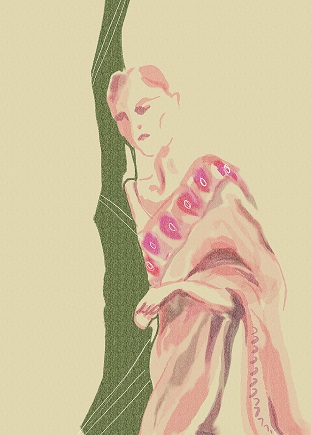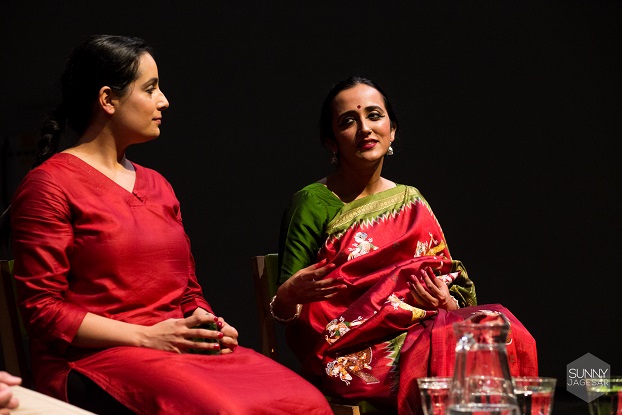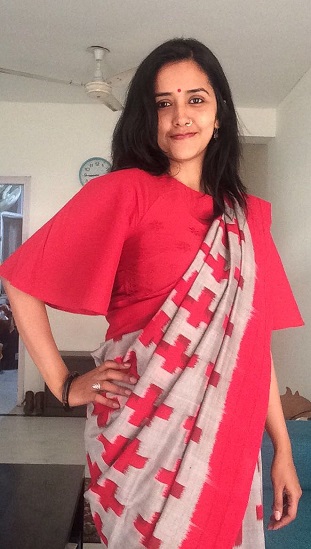How the drape holds meaning and memory for the desi mind, body, and soul. A series of interview-vignettes, showcasing uber serious sari love, brought out via passion, history, politics, through interviews with people across the spectrum who love to drape it, and also, talk about it! Catch up with Chapter One for the interview with Laila Tyabji, impassioned crafts activist and co-founder of Dastkar, and Chapter Two to hear from filmmakers Shabani Hassanwalia and Paromita Vohra.

* * *
Silly Saree days
they wrap me up
in giddying fabric
and giggly borders.
Tracing my contours
the borders travel
across the length and breadth of me
a journey into the centre of my earth.
— “Silly Saree Days”
from The Poetic Saree, a compilation of poems by Jaya Mehta

Odissi performers, soul sisters, actual sisters, gorgeous sari pact-ers — you could almost mistake Jaya Mehta and Swaati Vivek for twins! Their relationships with the garment are similar too, and they are both exponents of the same school of Odissi — it’s what lends both Swaati and Jaya a strong sense of the body. Both of them are wordsmiths and they are both mothers.
And yet, each inhabits a space in the spectrum of womanhood that is special to only her, which she carved out as her own. Tune in, for what makes the sari special to them, in this edited tête-à-tête with Swaati and Jaya…
Odissi & Sari
Swaati: Maybe in my head, in my ideal state I see myself — or want to see myself — as those women in the sculptures (in the temples of Orissa). Those shalbhanjikas and dalmalikas. And the closest I feel to being like that, in everyday life, is when I wear a sari.
Jaya: The way we tie the Odissi sari, in dance, connects us even more deeply, with our dancing self. Indian classical dance connects us with Indian Arts and our deepest personal self so incredibly, that the Odissi sari just transports us there in seconds. Once in that sari, we are in our dance element, ready to plunge and ready to receive so beautifully.

Sari & Me
Jaya: I think the sari was for me in school, a lot about breaking out of the super studious, ugly duckling image I felt. I always believed that I was a beautiful swan, and the sari made me enjoy my beauty right since then. Unlike the school uniform, which did nothing to make me feel beautiful.
Swaati: I realized sometime in my 30s, that there is only one way to wear a sari: you own it. You take all the shoulds, all the types, all the ‘proper’s, and shake them up until the faaltu bits fall off and you’re left with only what really works for you. So, for me, sari is uberfeminine (I can’t wear boxy tops with it), curvy (and so I have to drape it in a way that’s fitted and not loose or boxy), and supercomfortable (so I wear only light cottons, not stiff-starchy, not too dressy, and I wear them completely pinned up and hands-free, and really low-waisted so I can eat whatever the fuck I want all day — which is also why I don’t wear pants anymore — can’t stand anything digging into my waist or grabbing my crotch through the day).
And the one thing I do to make the sari mine, is the blouse — I wear vests, croptops, bodysuits with saris, rarely a proper blouse. It’s just something I started doing after having a baby (because none of the blouses would fit) and now I feel that it just makes the sari so modern and so comfortable. And so me.
Jaya: For me sari is everyplace wear. I wear it to my children’s school to pick them up, to formal events and to my Artistes’ after-talk in the India Dance Festival in Netherlands. I also wore it on the flight and when I arrived there! My sister-in-law was quite surprised! She thought that traveling abroad I will refrain from my sari-wearing self!
Sari & The Nation
Jaya: The range of art and craft forms in the around 30 countries (states) within our country is astonishing. In the Sari, all these art forms come together. A man grows the cotton/silk, another sits and weaves it, another person could be block printing or embroidering it. Somewhere, motifs from life, from paintings, sculptures, rural life, nature, percolate deeply into the creation of a sari. You cannot divorce the sari from nature. Rural India is still tied up close with nature, from there come our saris, not really from Sabyasachi or any designers.
Swaati: The moment it becomes this great upholder of Indian nari-panti or this great responsibility towards heritage and culture, it will die.
A sari is a lot about touch, so many yards of fabric flowing around you.
Jaya: We are a culture that embraces touch and all senses as well. Like the experience of a temple, involves all our senses. A sari is a lot about touch, so many yards of fabric flowing around you. It touches you in a way no garment can, there’s just so much more touch! Like living in India, it means more engagement and more warmth of connectedness. It also means a wider canvas of color, patterns and beauty to swim in.
Politics in my Pleats
Swaati: Instead of admonishing women for not wearing a sari, designers like Sabyasachi should make saris that lend themselves to women’s personalities, in a way that it says more than ‘I’m a connoisseur of fine things or dying art traditions’ — which is what most of his patrons seem to be saying at the moment.
For all his life’s work with weavers, the fact is that Sabyasachi has not made the sari liveable, breathable, ownable. His saris are still showpieces, to be worn once in a lifetime, in prescriptive formats. He has no right then, to tell women that they must know how to wear a sari. I would say Masaba did more for the sari than he did: she put a pocket in it!
The sari is such a magnificent thing that it can lend itself to every possible metaphor, idea, conversation, project. So I’m not surprised that it’s being pulled into the most potent kind of conversation these days — which is political… We don’t have many metaphors — let alone physical objects that we can wear on our person — like that anymore. We live in a literal world of sharp binaries and surface-level meaning for everything.
A singing saree
yellow, silky notes
woven with sacred chants
only I can hear.
As you wore it, washed it
did you grandma
weave these chants
into yellow silk?
— “Grandma’s Yellow”
from The Poetic Saree, a compilation of poems by Jaya Mehta
And on that note, we turn to the power of the political idea. Up next, the feisty feminists, Jasmine Lovely George and Sabika Naqvi. Watch out for Chapter Four of Sari Stories.
* * *
Pooja Pande is a writer-editor who grew up in, considers home, and hence has a suitably complex love-hate relationship with the capital city of India, Delhi. Her first book is Red Lipstick, a literary-styled memoir on celebrity transgender rights activist Laxminarayan Tripathi. Find her on Twitter at @derrindo.












